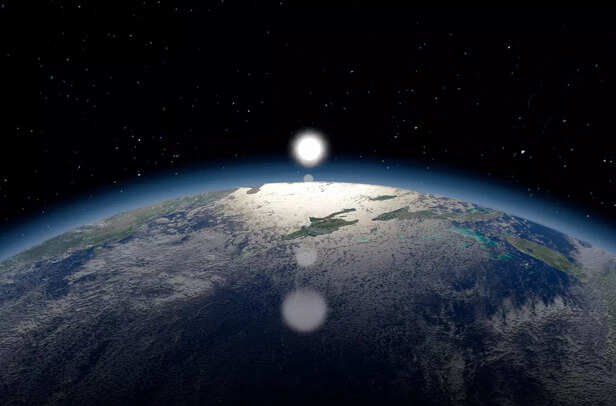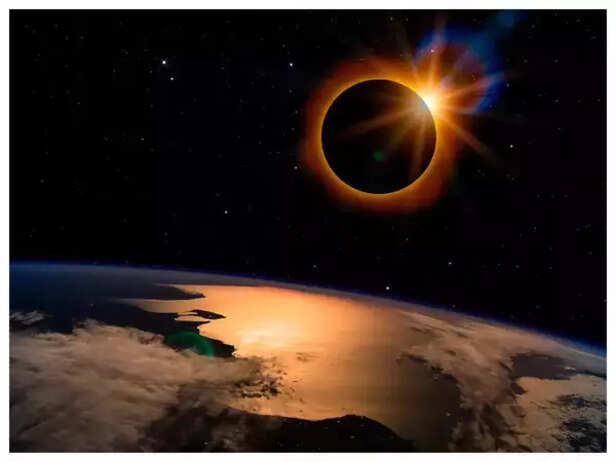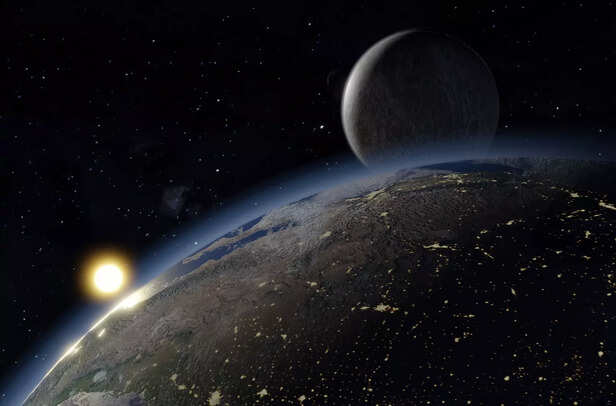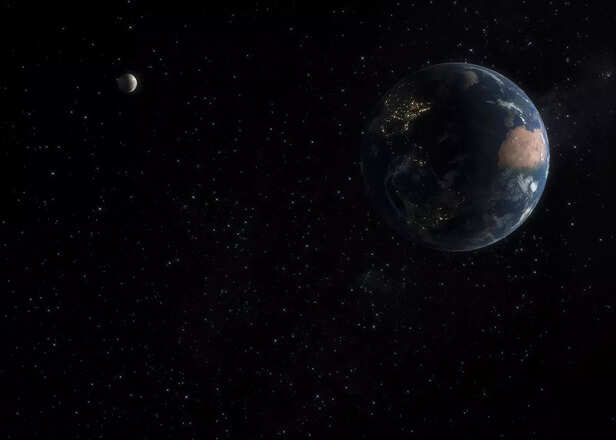Ever Wondered How Surya Grahan Looks from Space?
Mili verma | Mar 27, 2025, 21:29 IST
Have you ever imagined how a solar eclipse, or Surya Grahan, looks from space? Unlike the breathtaking sight from Earth, where the Sun momentarily disappears behind the Moon, the space view offers an entirely different perspective. From satellites and space stations, the eclipse appears as a massive dark shadow sweeping across Earth’s surface. Discover how solar eclipses from space have advanced our understanding of the Sun, Earth’s atmosphere, and celestial mechanics.
Imagine you are floating in the vastness of space, looking down at Earth. Suddenly, a dark shadow begins to creep across the planet's surface, a celestial dance between the Sun, Moon, and Earth. This awe-inspiring event is a Surya Grahan (solar eclipse), but from space, it looks entirely different from how we see it on Earth. While people on the ground experience momentary darkness, astronauts and satellites witness a moving shadow engulfing parts of the planet. So, how does Surya Grahan from space appear? Let’s explore this cosmic spectacle through the eyes of satellites, astronauts, and space telescopes.
Understanding a Solar Eclipse:

A solar eclipse (Surya Grahan) occurs when the Moon passes between the Sun and Earth, blocking sunlight and casting a shadow on Earth. Depending on the alignment, the eclipse can be total, partial, or annular. On Earth, we see the Sun being partially or completely obscured, but from space, the event reveals a stunning planetary phenomenon.
A Cosmic Perspective: How a Solar Eclipse Looks from Space
When viewed from space, Surya Grahan space view is a surreal sight. Unlike the sky-darkening experience on Earth, astronauts aboard the International Space Station (ISS) witness a rapidly moving dark spot—Earth’s shadow—gliding across the surface. This shadow is called the umbra, and it marks the path of totality where the eclipse is most intense. The outer, lighter shadow, known as the penumbra, extends beyond, creating a gradient effect.
Astronauts’ View of Surya Grahan from Space
Astronauts onboard the ISS have described solar eclipse seen from outer space as breathtaking. The ISS orbits Earth at approximately 28,000 km/h, allowing astronauts to witness multiple eclipses in a short time. Unlike the Earth-bound view, they see a massive dark circle moving over continents and oceans, a reminder of the delicate alignment of celestial bodies.
Satellite Images of Surya Grahan in Space
Advanced satellites like Himawari-8, GOES, and NASA’s DSCOVR capture real-time images of solar eclipses from space. These satellites provide an incredible solar eclipse from satellite perspective, showing how the Moon’s shadow moves across Earth. The images highlight the contrast between the sunlit parts of Earth and the shadowed regions, helping scientists study atmospheric changes during an eclipse.
How Satellites Capture Surya Grahan from Space:

From space, a solar eclipse seen from outer space appears as a dynamic shadow cast upon Earth's surface. The umbra, the darkest part of the shadow, moves rapidly due to Earth’s rotation and the Moon’s orbit. This movement creates a visual effect similar to a shadow sweeping across a globe. The speed and shape of the shadow depend on the type of eclipse and the relative positions of the Sun, Moon, and Earth.
The Speed of the Moving Shadow
The shadow can travel at speeds up to 2,400 km/h at the equator and slows down as it moves towards the poles. This speed variation means different regions experience totality for different durations, typically lasting only a few minutes.
Historical Solar Eclipses Captured from Space:

In recent decades, space-based observations have given us remarkable images of solar eclipses:
Observing a solar eclipse from space is more than just a visual delight; it is crucial for scientific research. Some key discoveries include:
Throughout history, different cultures have interpreted solar eclipses in unique ways:
Eclipses can affect spacecraft in various ways:
Upcoming missions will provide even better eclipse insights:
Witnessing Surya Grahan Beyond Earth:

Seeing Surya Grahan from space offers a unique and mesmerizing perspective. While people on Earth experience the dramatic darkening of the sky, astronauts, satellites, and space telescopes capture an extraordinary moving shadow across the planet. These space-based observations are not only visually stunning but also provide valuable scientific insights into solar and atmospheric phenomena.
Next time you witness a solar eclipse from Earth, imagine how it looks from space—where the celestial ballet unfolds on a planetary scale, reminding us of the vast and intricate beauty of our universe.
Explore the latest trends and tips in Health & Fitness, Travel, Life Hacks, Fashion & Beauty, and Relationships at Times Life!
Frequently Asked Questions ( FAQ's)
Understanding a Solar Eclipse:

The Shadow Dance on Earth
A solar eclipse (Surya Grahan) occurs when the Moon passes between the Sun and Earth, blocking sunlight and casting a shadow on Earth. Depending on the alignment, the eclipse can be total, partial, or annular. On Earth, we see the Sun being partially or completely obscured, but from space, the event reveals a stunning planetary phenomenon.
A Cosmic Perspective: How a Solar Eclipse Looks from Space
When viewed from space, Surya Grahan space view is a surreal sight. Unlike the sky-darkening experience on Earth, astronauts aboard the International Space Station (ISS) witness a rapidly moving dark spot—Earth’s shadow—gliding across the surface. This shadow is called the umbra, and it marks the path of totality where the eclipse is most intense. The outer, lighter shadow, known as the penumbra, extends beyond, creating a gradient effect.
Astronauts’ View of Surya Grahan from Space
Astronauts onboard the ISS have described solar eclipse seen from outer space as breathtaking. The ISS orbits Earth at approximately 28,000 km/h, allowing astronauts to witness multiple eclipses in a short time. Unlike the Earth-bound view, they see a massive dark circle moving over continents and oceans, a reminder of the delicate alignment of celestial bodies.
Satellite Images of Surya Grahan in Space
Advanced satellites like Himawari-8, GOES, and NASA’s DSCOVR capture real-time images of solar eclipses from space. These satellites provide an incredible solar eclipse from satellite perspective, showing how the Moon’s shadow moves across Earth. The images highlight the contrast between the sunlit parts of Earth and the shadowed regions, helping scientists study atmospheric changes during an eclipse.
How Satellites Capture Surya Grahan from Space:

Satellites Capture Surya Grahan from Space
- Himawari-8 (Japan): Provides time-lapse images of Surya Grahan space view, showing the moving shadow over the Pacific region.
- GOES (USA): Delivers high-resolution images of the solar eclipse's effect on Earth's weather patterns.
- DSCOVR (NASA): Positioned at Lagrange Point 1, it captures full-disk images of Earth with the Moon’s shadow creating a dark blotch during an eclipse.
From space, a solar eclipse seen from outer space appears as a dynamic shadow cast upon Earth's surface. The umbra, the darkest part of the shadow, moves rapidly due to Earth’s rotation and the Moon’s orbit. This movement creates a visual effect similar to a shadow sweeping across a globe. The speed and shape of the shadow depend on the type of eclipse and the relative positions of the Sun, Moon, and Earth.
The Speed of the Moving Shadow
The shadow can travel at speeds up to 2,400 km/h at the equator and slows down as it moves towards the poles. This speed variation means different regions experience totality for different durations, typically lasting only a few minutes.
Historical Solar Eclipses Captured from Space:

Solar Eclipse
In recent decades, space-based observations have given us remarkable images of solar eclipses:
- 1999 Total Solar Eclipse: The Mir space station captured one of the first high-quality space-based images of a Surya Grahan.
- 2017 Great American Eclipse: NASA’s DSCOVR satellite recorded the eclipse in stunning clarity from a distance of 1.5 million km.
- 2021 Antarctica Eclipse: The Himawari-8 satellite provided real-time views of the eclipse shadow moving over the icy continent.
Observing a solar eclipse from space is more than just a visual delight; it is crucial for scientific research. Some key discoveries include:
- During totality, the Sun’s outer atmosphere (corona) becomes visible.
- Space telescopes like SOHO and SDO study coronal activity, helping scientists understand solar flares and space weather.
- During totality, the Sun’s outer atmosphere (corona) becomes visible.
- Space telescopes like SOHO and SDO study coronal activity, helping scientists understand solar flares and space weather.
- Satellites track temperature and weather shifts caused by sudden darkness.
- Eclipses affect ionospheric layers, influencing communication signals.
- Satellites track temperature and weather shifts caused by sudden darkness.
- Eclipses affect ionospheric layers, influencing communication signals.
- High-resolution satellite data helps refine models of the Moon’s topography by analyzing how its shadow interacts with Earth’s surface.
- High-resolution satellite data helps refine models of the Moon’s topography by analyzing how its shadow interacts with Earth’s surface.
Throughout history, different cultures have interpreted solar eclipses in unique ways:
- Ancient India: Hindu mythology describes the eclipse as the demon Rahu swallowing the Sun.
- China: Ancient Chinese believed dragons were eating the Sun, leading to loud drumming to scare them away.
- Norse Mythology: The Vikings thought wolves chased the Sun and Moon, causing an eclipse when they caught up.
Eclipses can affect spacecraft in various ways:
- Communication Disruptions: Temporary loss of signals due to ionospheric changes.
- Power Supply Variations: Solar-powered satellites experience sudden energy dips during an eclipse.
- Scientific Opportunities: Space agencies time solar studies to coincide with eclipses for better data collection.
Upcoming missions will provide even better eclipse insights:
- NASA’s Artemis Missions (2025+): Astronauts on the Moon will observe eclipses from a new vantage point.
- ESA’s Vigil Mission: Will monitor the Sun and its effects on eclipses.
- Private Space Companies: Space tourism might soon offer commercial solar eclipse flights.
Witnessing Surya Grahan Beyond Earth:

Solar Eclipses Impact Space Missions
Seeing Surya Grahan from space offers a unique and mesmerizing perspective. While people on Earth experience the dramatic darkening of the sky, astronauts, satellites, and space telescopes capture an extraordinary moving shadow across the planet. These space-based observations are not only visually stunning but also provide valuable scientific insights into solar and atmospheric phenomena.
Next time you witness a solar eclipse from Earth, imagine how it looks from space—where the celestial ballet unfolds on a planetary scale, reminding us of the vast and intricate beauty of our universe.
Explore the latest trends and tips in Health & Fitness, Travel, Life Hacks, Fashion & Beauty, and Relationships at Times Life!
Frequently Asked Questions ( FAQ's)
- Can you see a solar eclipse from space?Yes, astronauts and satellites can see a solar eclipse as a moving shadow across Earth.
- What did Einstein prove with an eclipse?Einstein's 1919 eclipse experiment confirmed his theory of general relativity by showing that gravity bends light.
- Is Surya Grahan visible from India?Yes, but visibility depends on the eclipse’s path and timing, as not all solar eclipses are seen from India.
- Is it OK to look at a solar eclipse?No, looking at a solar eclipse without proper eye protection can cause serious eye damage.
